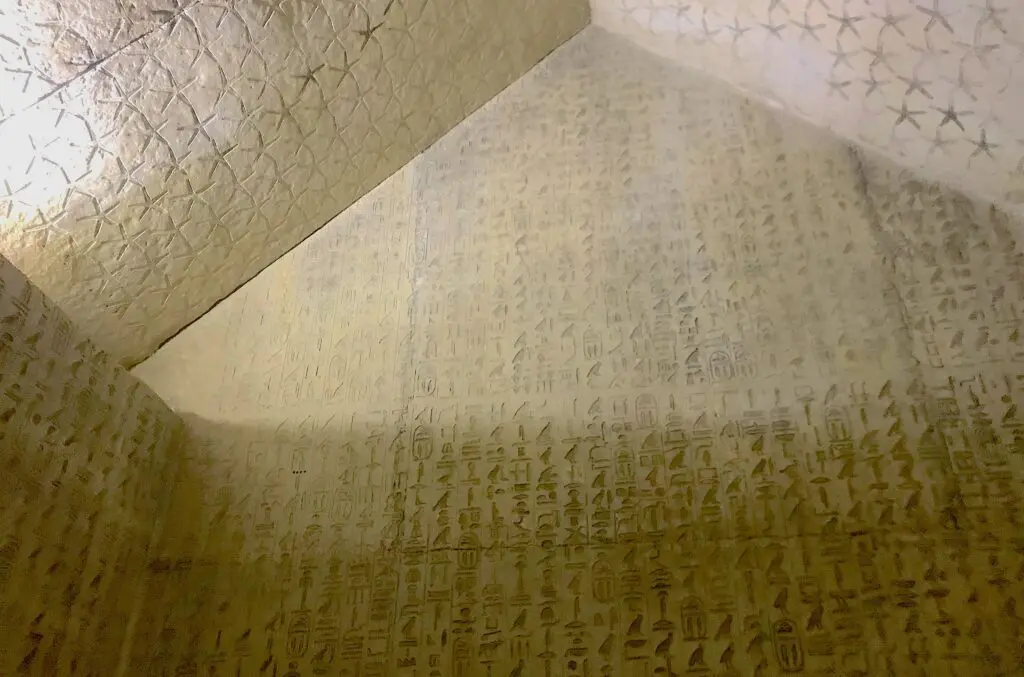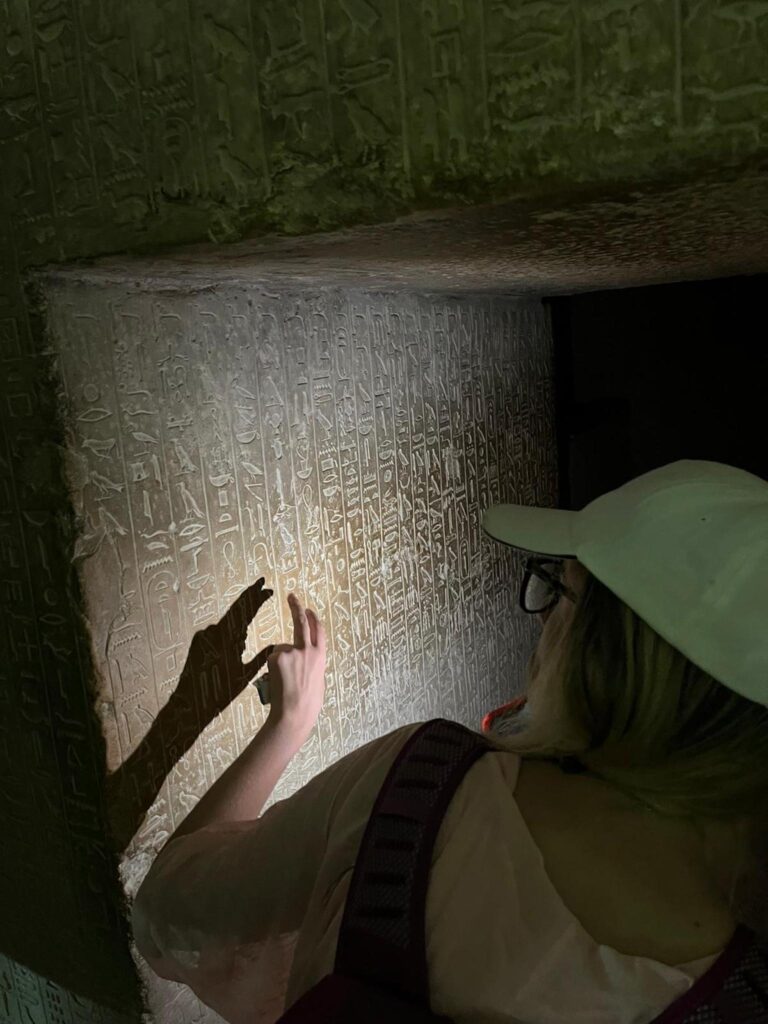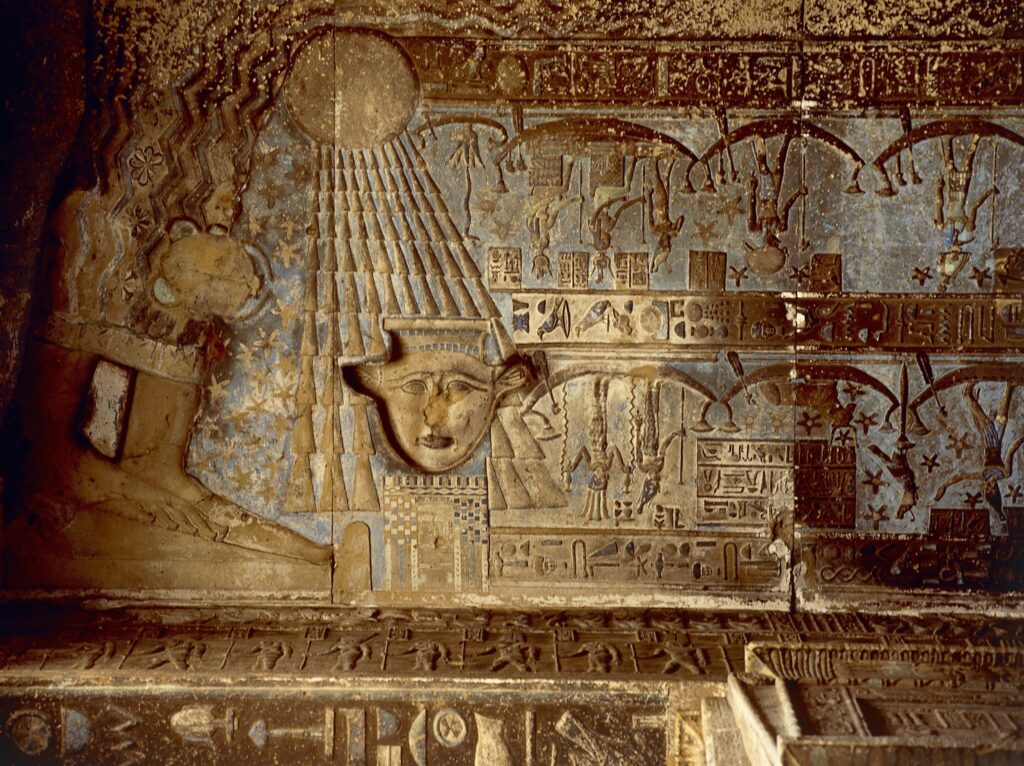What Ancient Egyptians Knew About Meteorites—Long Before Modern Astronomers

"(The king) Unis seizes the sky and splits its iron."
Inscribed in hieroglyphs in a 4,400-year-old pyramid, this sentence evidences that ancient Egyptians understood the extraterrestrial origin of iron-rich meteorites—thousands of years before European scientists reached the same conclusion.
Outside of folklore, this knowledge died with the ancient world, along with the associated myths, languages, writing systems, and rituals. Not until the late 18th century, in the intellectual circles of Europe, was the idea that meteorites arrived from the sky timidly proposed again.
When it comes to the history of science, particularly astronomy, ancient Egyptians have not received the credit they deserve. Unlike Babylonians and Greeks, Egyptians did not use mathematical models to predict astronomical phenomena for much of their history. Their knowledge of meteoritic iron was not recorded in the descriptive, linear manner of scientific books. Rather, it was embedded in metaphors and rituals.
As an Egyptologist, I have spent years trying to harness the power of ancient symbols—especially those used in hieroglyphic writing—to uncover the knowledge and beliefs of past people of the Nile. Through this work, I have abandoned my modern-day preconceptions about science to understand, recover, and appreciate Egyptian scientific achievements.
Recently, by analyzing hieroglyphs in an ancient collection of rituals known as the Pyramid Texts, I learned that Egyptians had discovered long ago a crucial fact about iron: It can come from meteorites.
UNDERSTANDING IRON
Many scholars would say the Iron Age began about 3,300 years ago in Anatolia, where the Hittites invented a method for extracting metallic iron from earthly ore minerals such as hematite. This smelting process requires creating and controlling temperatures above 2,300 degrees Fahrenheit. Though iron ores were common in the Egyptian deserts, ancient Egyptian people probably did not master iron smelting until 2,600 years ago—about 700 years after the Hittites and other societies to the north.
Yet iron objects appear much earlier than that in Egypt. In fact, the world's oldest-identified iron objects are small beads that come from a burial in Gerzeh, a roughly 5,300-year-old village in northern Egypt. Other pre–Iron Age iron objects have been found in Egypt, including an amulet in the 4,000-year-old tomb of Queen Aashyet in Deir el-Bahari and a dagger blade in King Tutankhamun's tomb.
Where did this metal come from, centuries before iron smelting?
Meteorites.
Modern science teaches us that iron exists in metallic form within the core of asteroids. Small fragments of these rocky objects sometimes reach Earth as intact, iron-rich meteorites.
Compared with smelted iron, meteoritic iron generally has larger mineral crystals and elevated levels of other elements, such as nickel and cobalt. Studies in the past decade analyzing these features have confirmed that ancient Egyptians likely used this iron from the sky to fashion the Gerzeh beads, Tutankhamun's dagger, and other funerary items.
But did the ancients know that the iron objects they were using in funerary rituals came from outer space?
THE UNIVERSE IN HIEROGLYPHS
I first became interested in ancient Egyptians' knowledge of iron while studying the texts of another past society. As part of my doctorate, I also studied Sumerian, a language first spoken some 5,000 years ago in Mesopotamia. Three lexemes, or combinations of signs, have been proposed for how the Sumerians wrote "iron." All three options contain the sign for sky.
Learning this made me think of the second millennium B.C. Egyptian word for "iron": bjA n pt ("the iron of the sky"). I wondered whether both Sumerians and Egyptians knew iron can be found in meteorites.
Moreover, the Sumerian words predated the Egyptian one by several centuries. Did that mean the knowledge originated in Mesopotamia and spread to Egypt?
Investigating further, I learned that ancient Egyptians must have discovered celestial iron independently, more than 1,000 years before the earliest attestation of bjA n pt. Around the same time as Sumerians, Egyptians had been composing ritual recitations about the sky and the iron (bjA) in it.
The earliest-known Egyptian references to iron in connection with stars, meteoroids, and the sky come from the Pyramid Texts, a collection of inscriptions carved on the inner walls of pyramids that once housed the bodies of Fifth to Eighth Dynasty Egyptian kings and queens who ruled about 4,400–4,100 years ago. Encompassing different oral and written styles, the Pyramid Texts likely were funerary liturgies that priests would have uttered to help the royal deceased reach an afterlife in the sky.
The Pyramid Texts provide insights into the Egyptian understanding of the universe. The inscriptions present the sky as an iron bowl containing water, pieces of which can fall to Earth as meteorites or rain. But this scene is not easy to grasp from a superficial reading of the texts, especially in translation. It is encapsulated in metaphors and spread across several unconnected passages.
To solve this puzzle, I had to decipher the metaphors and link the passages.
The writing system provided some keys. Egyptian hieroglyphs represent sounds (like an alphabetic system), ideas (for example, the floorplan of a house can mean "house"), and classificatory fields (the same house plan at the end of a word can denote that the word refers to a type of building). Hieroglyphs provide a nuance of iconicity that is lost in modern translations.
In the Pyramid Texts, the word for iron is written with a hieroglyph that represents a hemispherical container of water—how the Egyptians perceived the sky. Iron and sky are interchangeable in the texts, which is why passages describe the dead sailing the iron and the king needing to break an iron barrier to reach the sky.
Broader knowledge of Egyptian religion also helped me make sense of the texts. For example, the goddess Nut personified the sky. Ancient Egyptians believed a deceased king would be resurrected by returning to the primordial, amniotic waters of Nut's womb. Thus, the same sign used for iron was used as a classifier for the words "uterus" and "well."
What could at first be dismissed as random, irrelevant associations of "unscientific" minds describing metals, women, and water turns out to be a byproduct of a scientifically correct interpretation of the provenance of meteoritic iron. In Egypt, 4,400 years ago, the word for iron could simply mean sky because the Egyptians knew iron was part of the sky.
IRON FROM THE SKY
Some scholars have reasonably pushed back against the possibility of this ancient knowledge because a meteorite hitting Earth remains a rare phenomenon to witness. How likely is it that someone saw a meteorite fall to Earth, found the resulting crater, and sourced metal from it? How would the meteoritic origin of iron be ascertained without physical or chemical analyses?
European Enlightenment scholars denied the folktales of extraterrestrial meteorites and argued that the mysterious "thunderstones" came from volcanoes or lightning strikes. However, reports of fallen meteorites and their hammering by locals are known since the Middle Ages. Like ancient Egyptians, these nonscientists probably gleaned meteorites' origin.
Knowledge survives centuries, or even millennia, without scientific texts. In ancient Egypt, it was embedded in metaphors, stories, and rituals that could be easily remembered.
Victoria Almansa-Villatoro is an Egyptologist who focuses on ancient texts and the use of language to encapsulate and express power dynamics and implied knowledge. She received her Ph.D. from Brown University in 2022 and in the same year was elected as a Junior Research Fellow at the Harvard Society of Fellows (2022–2025). Some of the topics she has published on include uncovering how ancient Egyptians used persuasion without leveraging authority and unraveling the iconic metaphors in hieroglyphs. Almansa-Villatoro works with the Ancient Egypt Research Associates' archaeological project in Giza (Egypt) as a sealings expert and with the Nuri Archaeological Expedition to the royal necropolis and pyramids of Nuri (Sudan) as an assistant director. She is also an assistant editor at the Journal of Ancient Egyptian Interconnections.
-- Sent from my Linux system.



No comments:
Post a Comment